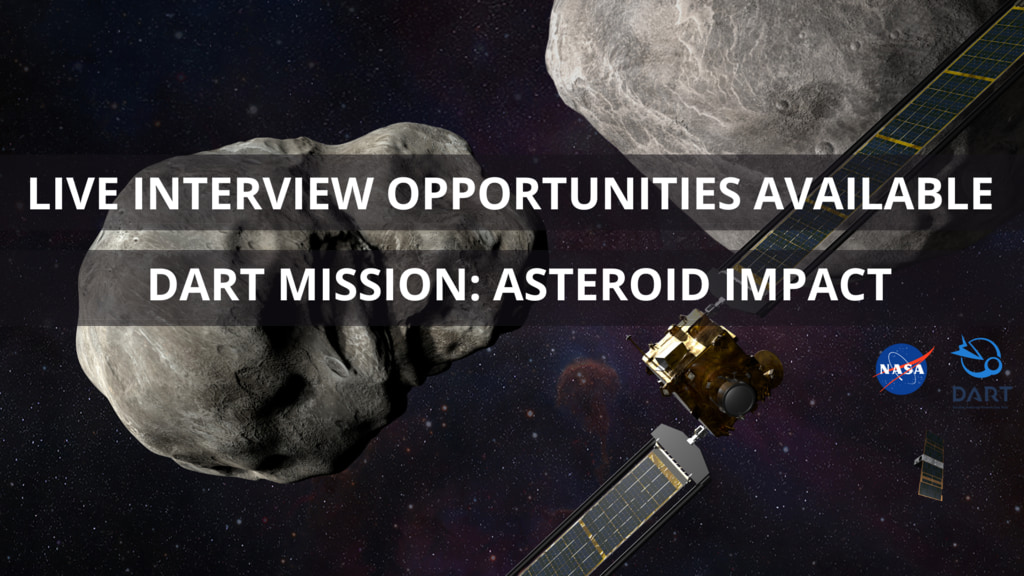NASA Just Days Away From Launching Humanity’s First-Ever Asteroid-Deflecting Mission Live Shots

Click here for the DART PRESS KIT
Click here for B-ROLL resources
Quick link for cut Live Shot B-ROLL
Click here for quick link to CANNED INTERVIEW with Tom Statler / DART Program Scientist
NASA’s DART Mission Will Intentionally Crash A Spacecraft Into A Small Asteroid To Test Planetary Defense Capabilities
On Nov. 23 at 10:21 p.m. PST/ Nov. 24 at 1:21 a.m. EST, NASA will be launching its first-ever mission to redirect an asteroid. This asteroid is not a danger to Earth, but NASA is ready to test planetary defense capabilities for the future; no super powers or drilling teams needed. The Double Asteroid Redirection Test (DART) spacecraft will be headed towards the asteroid Didymos and its small moon and impact target, Dimorphos. DART will intentionally collide with Dimorphos to alter the path of this small asteroid around the larger asteroid Didymos. NASA’s goal with DART is for us to be prepared with a planetary defense capability if an asteroid is ever discovered to be on a collision course with Earth in the future.
Small fragments of asteroids, from pebble-sized to person-sized, hit the Earth every day. Dimorphos is about the height of the Washington Monument (but much bulkier). An asteroid this big could cause severe damage if it were to collide with our planet. No known asteroid poses an impact threat to Earth for the next 100 years, but the danger from asteroids not yet discovered is still unknown. The DART mission will be the first of its kind to alter the path of an asteroid so we can observe how a real asteroid responds to a deflection attempt, should we ever need to deflect one.
● Live or taped interviews will be offered on Tuesday, Nov. 23 between 6:00 a.m. EST / 3:00 a.m. PST - 1:00 p.m. EST / 11:00 a.m. PST
● Click here to request an interview: https://forms.gle/SzpLCiDPdJEP7RrA8
Suggested Anchor Intro:
Unlike Hollywood sci-fi movies, we’ve rarely had to deal with incoming asteroids on Earth, but NASA is taking no chances! Later this evening/ Tomorrow NASA will launch the Double Asteroid Redirection Test or DART. The first of its kind, DART will test the idea of deflecting an asteroid by colliding with the small moonlet in a double asteroid system. Here to tell us more about this mission is NASA expert xxxx.
Suggested Questions:
The DART mission sounds like it could be right out of science fiction. Can you tell us what this mission is?
NASA says the DART mission is about planetary defense. Can you tell us what planetary defense is, and what we’re hoping to learn about it from DART?
Since DART is going to try to redirect an asteroid, why is it colliding with the little moonlet instead of the larger asteroid itself?
What is the likelihood of an asteroid being a big enough danger to Earth that we would need to use this technology to avoid a huge natural disaster?
Where can our viewers go to learn more about DART?
Questions for longer interviews:
How will we find out what happens to Dimorphos after the collision of the DART spacecraft?
How fast will the DART spacecraft be traveling?
By how much is this redirection test going to move this asteroid moonlet?
Why are we redirecting the asteroid and not blowing up the asteroid?
What is NASA’s planetary defense strategy?
There is a little CubeSat traveling along with DART, can you tell us about that?
Associated cut b-roll for live shot interviews. Clips are separated by a slate with the corresponding question.
Credit: NASA/Johns Hopkins APL
Canned interview with Tom Statler / DART Program Scientist, TRT 7:49. Full transcript is available under the download button.
For More Information
Credits
Please give credit for this item to:
Credit: NASA/Johns Hopkins APL
-
Producers
- Michelle Handleman (KBR Wyle Services, LLC)
- Christina Brooke Mitchell (KBR Wyle Services, LLC)
- Jessica Sansarran (NASA)
Release date
This page was originally published on Tuesday, November 16, 2021.
This page was last updated on Wednesday, May 3, 2023 at 1:43 PM EDT.
